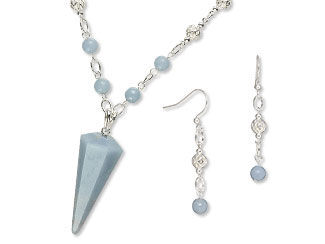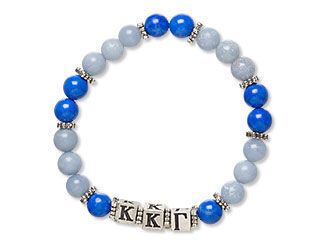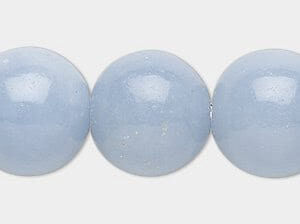Angelite Meaning and Properties
Angelite History
Angelite, also known as anhydrite or angel stone, is a glacier blue- or lilac blue-colored soft stone that has a white center and snow-white flecks with occasional brown or rusty inclusions.
A relatively recent discovery in the mineral and gem world, angelite was discovered in 1987 in Peru. The name ahnydrite comes from the Greek anhydras--meaning "without water"--a reference to angelite being a gypsum that has completely lost all hydration, becoming a stone that is "without water."
Angelite Metaphysical Properties
Angelite is thought to improve spirituality and spiritual awareness, with a peaceful energy that is calming and soothing. Many believe it promotes communication and self-express while dispelling fear, anger and anxiety.
Angelite is closely related to the astrological sign of Aquarius. Because of its blue color, angelite is associated with the throat, third eye and crown chakras.
Angelite Geological Properties
Angelite is a form of anhydrite, which is a crystal made of calcium sulfate. The crystals are formed in places where gypsum stones had previously been in contact with water, which then evaporates, leaving anhydrite crystals behind. The stone is formed from celestite (another form of gypsum) that has been compressed for many millions of years. Anhydrite gypsum was originally found in Peru. It has since been found in Britain, Germany, Poland, Libya, Egypt and Mexico.
|
|
|
|
|
|
|
|
|
|
|
|
|
|
|
|
|
|
Proper Care of Angelite
Anhydrite, including angelite, is an inherently unstable stone that absorbs moisture at the drop of a hat. It can also be easily marred, so protect it from scratches, sharp blows or large temperature changes that will fracture, shatter or chip it. When anhydrite--a soft mineral--is exposed or immersed into water, it transforms into gypsum. Therefore, do not wear angelite while perspiring, bathing or swimming. It is best cleaned with a soft, dry cloth.
Designing with Angelite
The soft blue of angelite teams up exceptionally well with other pastel-colored gemstones and analogous gemstones colors such as riverstone, blue lace agate and amethyst. For a complementary color pairing, angelite provides a great base to draw attention to orange/red gemstones such as carnelian, sunstone, amber and other forms of agate or banded jaspers. Learn more about color pairings with our color wheel. Angelite looks especially beautiful when used with sterling silver or similarly light-colored metal materials. Because angelite can be easily marred care should be taken when knotting between beads and it is advisable to limit this stone's use to necklaces, earrings and hair jewelry, avoiding use in bracelets, rings and anklets due to the likelihood of damage from movement.
A Couple Design Inspirations to Get You Started
Shop for Angelite
**Please note that all metaphysical or healing properties listed are collected from various sources. This information is offered as a service and not meant to treat medical conditions. Fire Mountain Gems and Beads® does not guarantee the validity of any of these statements.
How did you like this resource? Your feedback helps us provide resources that matter to you most.
Copyright Permissions
All works of authorship (articles, videos, tutorials and other creative works) are from the Fire Mountain Gems and Beads® Collection, and permission to copy is granted for non-commercial educational purposes only. All other reproduction requires written permission. For more information, please email copyrightpermission@firemtn.com.




